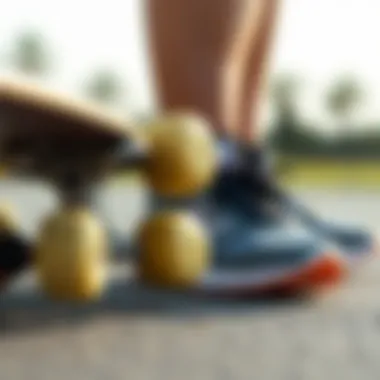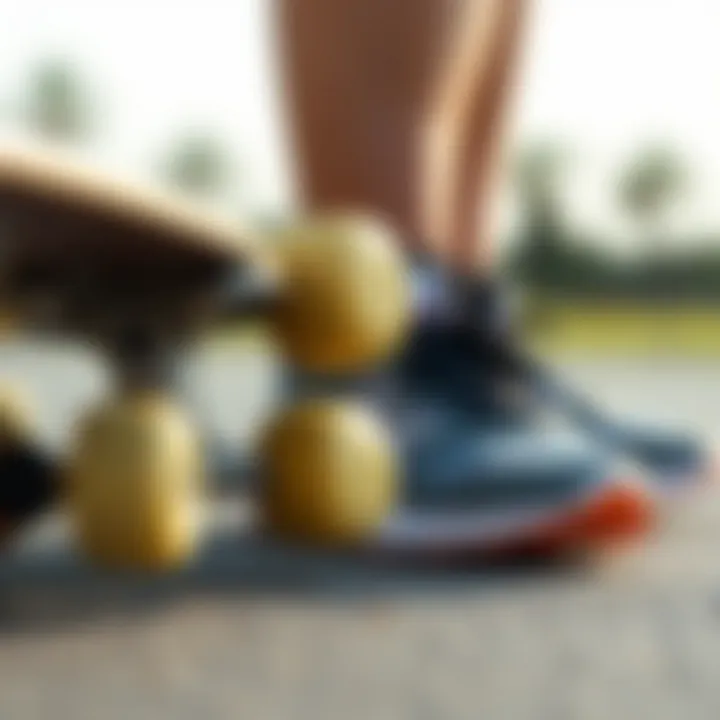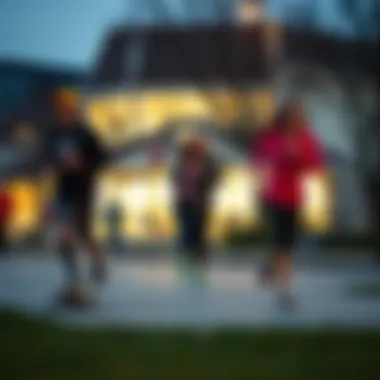Exploring the Connections Between Skateboarding and Jogging


Intro
In the dancing interplay of movement and rhythm, skateboarding and jogging present a tapestry woven with threads of culture, creativity, and urban expression. On the surface, these two activities may seem worlds apart—one electrifying and spontaneous, the other meditative and steady. Yet, as we peel back the layers, we find a myriad of parallels that bind them together in contemporary urban life.
Skateboarding, with its roots tracing back to the 1950s surf culture, has transformed into a global phenomenon. It's not merely a sport; it's a lifestyle, a form of self-expression, resonating with youth and subcultures alike. Conversely, jogging emerges as a simpler, yet equally profound pursuit. For many, it offers a chance to escape the chaotic rhythm of daily life, promoting mental clarity and physical well-being.
As we embark on this exploration, we aim to uncover the skills that practitioners of both skateboarding and jogging develop, the essential gear that supports their journeys, and the cultural impact they've made on the landscapes they traverse. By examining these facets, we can appreciate the nuanced ways in which these activities converge, creating a unique intersection in the fabric of urban living.
Skills Development
When it comes to developing skills, both skateboarding and jogging offer unique opportunities for growth and personal achievement. Though the means of progression differ, the underlying principle of mastery applies to both disciplines.
Trick Tutorials
For skateboarders, learning tricks can feel like unlocking levels in a video game. Each maneuver, be it a kickflip or a grind, requires patience, practice, and perseverance. Here are some beginner tricks to get started:
- Ollie: The foundational technique that allows riders to leap off the ground without grabbing the skateboard.
- Shuvit: A trick where the board spins 180 degrees under the rider's feet without the rider leaving the ground.
- Kickflip: An Ollie combined with a flick of the foot, making the board spin sideways.
For joggers, skills development revolves more around pace, form, and endurance. Learning proper running techniques is essential for preventing injuries and improving efficiency:
- Breathing Techniques: Implement rhythmic breathing patterns to maximize oxygen intake.
- Posture Awareness: Maintaining an upright posture helps in reducing strain on the body.
- Pacing: Understanding personal pace improves long-distance running experience.
Skill Progression Tips
Track your progress, whether it's mastering a new skateboard trick or building up your running distance. Here are some tips to advance your abilities:
- Consistency is Key: Establish a routine that allows for regular practice, honing skills over time.
- Diversity in Drills: Incorporate various techniques and exercises to promote balanced development.
- Join a Community: Engage with fellow enthusiasts, whether it's a skate park or a running group, fostering motivation and camaraderie.
"Developing skills through practice not only strengthens your body but also fortifies your spirit. Each small victory lays the foundation for larger achievements."
Gear Insights
Choosing the right gear plays an integral role in enhancing the experience for both skateboarders and joggers. While the aesthetics may differ, the emphasis on quality and functionality is paramount.
Skateboard Reviews
Selecting a skateboard that feels right is crucial. Consider the following factors:
- Deck Material: Maple wood offers durability and flexibility, essential for trick performance.
- Wheel Size: Larger wheels provide better shock absorption, especially on rough surfaces.
- Trucks: High-quality trucks enable better turning and stability during tricks, making a significant difference in performance.
Some noteworthy brands to look into are Element, Girl, and Almost—each offering unique styles and options tailored to different skill levels.
Safety Equipment Recommendations
Safety should always be a priority, regardless of your style. Crucial gear includes:
- Helmets: A sturdy helmet protects against head injuries and should fit comfortably.
- Knee and Elbow Pads: These provide extra cushioning during falls, especially for beginners.
- Wrist Guards: Prevents wrist injuries during skateboarding maneuvers and falls.
For joggers, footwear choice is vital in minimizing injury and enhancing performance. Look for shoes that offer adequate support and cushioning, specifically designed for running.
By examining the skills development and gear insights within skateboarding and jogging, we can see the continuous evolution and adaptation both activities undergo in urban environments. While practitioners may come from varied backgrounds, there exists a shared passion that binds them, creating vibrant communities around the streets they traverse.
Preface to Skateboarding and Jogging
In today’s fast-paced world, fitness and urban mobility have taken on new forms, leading to the emergence of diverse movement practices. Among these, skateboarding and jogging stand out not just as physical activities but also as cultural phenomena that have significantly influenced urban landscapes and social connections. This section serves as a gateway to understanding the intricate relationship between these two activities, shedding light on their respective merits and considerations. It invites us to reflect on how skateboarding, with its roots in creativity and self-expression, contrasts with jogging’s emphasis on health and mindfulness.
Understanding Skateboarding
Skateboarding isn’t just about gliding on a board with wheels; it encapsulates a lifestyle cultivated over decades. Originating from the streets of California in the late 1940s, skating has evolved into a platform for personal expression and creativity. Skaters routinely push the boundaries of physics and artistry, demonstrating extravagant tricks and styles. Each move tells a story — from the simple push-off for momentum to the intricate ollies and flips that defy gravity. This sport isn't merely physical but also mental, often demanding a sharp focus and an understanding of one’s environment.
- Culture of Creativity: Skaters often personalize their boards with unique designs, showcasing their personalities.
- Community Connection: Skate parks serve as melting pots where skaters come together, exchange tips, and celebrate their shared passion.
As seen in cities like Los Angeles and New York, skateboarding plays a crucial role in urban culture, impacting everything from aesthetics to community dynamics. This cultural impact makes understanding skateboarding essential, as it intertwines with how urban spaces are utilized and perceived.
The Popularity of Jogging
In stark contrast, jogging has emerged as a widely embraced form of exercise that caters to all demographics. Its surge in popularity began in the 1960s when fitness culture took root, and it continues to grow today. The appeal of jogging lies in its simplicity; one does not need elaborate equipment or an expensive gym membership. A good pair of shoes is often all that’s required to hit the pavement.
- Health Benefits: Numerous studies confirm jogging’s ability to enhance cardiovascular health and improve mental well-being.
- Accessibility: Whether it’s in the concrete jungles of urban centers or the serenity of parks, joggers can find spaces to run without needing specialized terrain.
Moreover, jogging fosters a sense of community as people join running clubs or participate in local races. It is a social activity that encourages camaraderie and collective goals, bridging gaps between strangers through shared pursuits. As the popularity of jogging continues its upward trend, understanding its underlying motivations becomes crucial, especially when compared to the more niche scene of skateboarding.
"Skateboarding and jogging may seem worlds apart, but both serve as vehicles for self-improvement and community engagement, illustrating the diverse ways individuals connect with movement in our urban landscapes."


Both skateboarding and jogging offer a multitude of benefits that extend beyond mere physical fitness. They contribute to mental health, provide social connections, and promote community spirit. By exploring these two activities, one gains insights not only into their distinctiveness but also into a shared ethos of movement, health, and creativity.
Cultural Context of Skateboarding and Jogging
Examining the cultural context of skateboarding and jogging reveals much about the societal influences that shape these activities. Both sports are not just physical exercises; they hold significant cultural value and social interactions. By understanding their backgrounds, we can appreciate how they mirror broader trends in society and influence urban life.
Historical Roots of Skateboarding
Skateboarding, having emerged in the late 1940s and early 1950s in California, began as a means for surfers to practice on land when the ocean was flat. The invention of the skateboard, initially a simple plank with wheels, marked the beginning of a new cultural wave.
- 1950s to 1960s: The early days of skateboarding reflected a youth-driven movement, as kids adopted the skateboard to imitate surfing.
- 1970s Growth: With the introduction of polyurethane wheels, skateboarding gained speed and precision. This decade saw the rise of skate parks and competitions, turning skateboarding into a recognized sport.
As skateboarding evolved, it became associated with rebellion and nonconformity, especially during the punk rock era of the 1980s. This connection between skateboarding and counterculture established it as not just a sport but a lifestyle, deeply ingrained in music, fashion, and art.
Jogging as an Urban Movement
While skateboarding grew from a surf culture, jogging emerged in the 1960s as part of a broader fitness revolution. It can be traced back to figures like Dr. Kenneth Cooper, whose book "Aerobics" popularized the benefits of running.
- 1970s Popularity: As health consciousness began to rise, jogging became a national phenomenon. The sport resonated particularly in urban areas, where people sought accessible ways to stay fit amidst growing sedentary lifestyles.
- Community Impact: Running clubs and organized races bolstered social ties within neighborhoods; they became a hub for community engagement, drawing people together.
In many cities, jogging transformed parks and streets into more vibrant public spaces. The visibility of runners contributed to a culture emphasizing health and activity, changing how urban dwellers interacted with their environment.
"Skateboarding and jogging both tell stories of resilience, creativity, and community, allowing individuals to connect beyond the mere act of movement."
As skateboarding parks became integral to youth culture, jogging paths shaped the urban fabric, offering avenues for exercise and community bonding. Understanding the story behind these activities deepens our appreciation of how they contribute to contemporary social landscapes and encourages more inclusive environments for all practitioners.
Benefits of Skateboarding
Skateboarding is more than just a leisure activity; it offers a plethora of benefits that extend beyond the mere thrill of gliding on four wheels. From physical fitness to social engagement, skateboarding presents a multifaceted influence on individuals and communities alike. Highlighting these benefits can provide insight into why skateboarding remains a staple in urban environments, often paralleling activities such as jogging.
Physical Health Benefits
Engaging in skateboarding can be a delightful path to improved physical health. The activity demands a blend of strength, balance, and cardiovascular endurance. Whether performing tricks on a half-pipe or simply cruising down the street, skateboarders exert a surprising amount of energy, often equivalent to running, if not more.
- Muscle Engagement: Skateboarding actively engages various muscle groups, particularly in the legs and core. As one navigates ramps and obstacles, the muscles in the thighs, calves, and abdomen work tirelessly to maintain stability and perform complex maneuvers.
- Cardiovascular Conditioning: Tackling different terrains, whether smooth sidewalks or rugged skate parks, keeps the heart in good shape. The constant push-and-pull associated with propelling a skateboard encourages increased heart rate, promoting overall cardiovascular health.
- Balance and Coordination: Skateboarding challenges and hones one’s balance and coordination. The body must adjust continuously to shifting weight, which improves proprioception – an essential skill not just in riding but in everyday physical activities.
In sum, the physical engagement that skateboarding demands makes it a robust exercise choice slotted nicely alongside jogging.
Mental Wellness and Skateboarding
Skateboarding also plays a pivotal role in mental wellness. As the wheels roll and tricks are landed, skateboarders often enter a state of flow—a psychological phenomenon where one becomes fully immersed in the activity. This produces several mental health benefits:
- Stress Reduction: Just like jogging, the rhythm of skateboarding can help alleviate stress. The focus required while skating offers a diversion from daily worries, allowing individuals to clear their minds. Many skateboarders describe the euphoric feel after a successful session, a natural high that stems from physical exertion combined with creativity.
- Community Connection: Skateboarding fosters community—be it at a local skate park or a neighborhood block. The camaraderie found in sharing tips, tricks, and experiences helps to create bonds that can be therapeutic. Just as running clubs cultivate friendships among joggers, skate parks serve as meeting grounds for like-minded enthusiasts.
- Confidence Boost: As riders enhance their skills, they often experience heightened self-esteem. Successfully mastering a trick can provide a sense of accomplishment, reflecting one’s dedication and ability to overcome challenges. This increase in confidence often spills over into other life aspects.
Skateboarding offers a unique blend of physical challenge and mental release, making it beneficial not just for the body but also for the mind.
Ultimately, the benefits of skateboarding position it as a unique counterpart to jogging. Both activities promote health and community, each in their own distinctive way.
Benefits of Jogging
Jogging serves as not just a means of physical fitness, but as a holistic practice that encompasses various benefits spanning both the body and the mind. In the context of our exploration, jogging is seen as an integral counterpart to skateboarding, offering a contrasting yet complementary form of movement that enriches the urban lifestyle. Understanding the significance of jogging’s benefits will allow enthusiasts of both sports to appreciate the nuances and overall contributions of each activity.
Cardiovascular Advantages
One of the most compelling reasons to lace up your running shoes is the impact jogging has on cardiovascular health. Studies show that consistent jogging strengthens the heart muscle. This improved efficiency means the heart can pump more blood with each beat, ultimately lowering resting heart rate over time. The ripple effects of this can be substantial:
- Enhanced Lung Capacity: Jogging deepens your breathing, leading to improved oxygen uptake.
- Lower Blood Pressure: Regular runners often experience reduced blood pressure due to increased blood flow and improved vascular function.
- Lower Cholesterol Levels: Jogging can help lower bad cholesterol levels while raising the good.
In essence, engaging in jogging can be seen as an investment in your long-term health.
"It’s not just about the miles; it’s about the heart behind every step taken."
Stress Relief and Mental Clarity
Beyond the physical realm, the mental health benefits of jogging are equally noteworthy. In today’s fast-paced life, stress can feel like a constant companion. However, when one hits the pavement, the rhythmic pounding of feet against the ground can work wonders for stress management.
Here are a few salient points regarding the mental well-being associated with jogging:
- Endorphin Release: Often dubbed the 'feel-good' hormones, endorphins flood the body during aerobic exercises like jogging. This can lead to what is commonly known as the "runner's high."
- Mindfulness Opportunity: The repetitive nature of jogging allows practitioners to enter a meditative state, making it easier to process thoughts and gain clarity.
- Increased Focus: As one engages consistently, mental sharpness may improve, resulting in better decision-making skills in other aspects of life.
Gear Involvement and Selection
When it comes to both skateboarding and jogging, the gear selection plays a pivotal role in enhancing the experience of each activity and ensuring safety. Using appropriate equipment not only aids performance but also helps prevent injuries, which can derail an active lifestyle. The considerations are different for each discipline, yet they carry a universal significance in the realm of sports.
Essential Skateboarding Equipment


The landscape of skateboarding gear has evolved tremendously. It’s more than just a deck, wheels, and trucks; it’s a carefully curated selection that can cater to style, performance, and safety.
- Skateboard Deck: It's where everything begins. The type of deck a skateboarder chooses can greatly affect their riding style. Options can range from deeper concaves for technical tricks to wider decks that offer more stability.
- Trucks: These are the metal parts that attach the wheels to the deck. A good pair of trucks allow better control and the ability to perform tricks. Choosing the right width that matches the deck is essential for balance.
- Wheels: They come in various sizes and hardness levels. Softer wheels absorb impacts better, making them suitable for rough terrains, while harder wheels help with speed and smooth surfaces. The right wheel can change how a skateboard feels on different terrains.
- Protective Gear: Helmets, knee pads, and elbow pads are vital. They safeguard against injuries during falls, which are part of the learning curve in skateboarding. Wearing proper protective gear is not just for beginners; even experienced riders can take spills.
- Apparel: The clothes skateboarders wear are part of their identity and can also offer functional benefits. Breathable fabrics allow for comfort during intense rides, while reinforced materials can provide additional protection.
In short, the right equipment allows skateboarders to express their individuality, improve their skills, and enjoy the sport while minimizing risks.
Jogging Essentials: Footwear and Gear
When it comes to jogging, one of the most important factors is what goes on your feet. But it's not just shoes; multiple elements can enhance the jogging experience.
- Running Shoes: The cornerstone of jogging gear. A well-fitted running shoe can reduce the risk of injuries like shin splints or plantar fasciitis. There are various types of running shoes designed for different foot types and running styles, so it's worth investing time to find the right pair.
- Moisture-Wicking Clothing: Joggers benefit from clothes that draw moisture away from the skin. Fabrics like polyester and Merino wool keep you cooler and reduce chafing.
- Smart Technology: Wearable gadgets like fitness trackers and smartwatches can help joggers monitor their performance. These devices often track pace, distance, and heart rate, providing valuable insights into training progress. Besides, running apps can connect joggers with communities or even provide personal coaching.
- Hydration Packs: For longer runs, staying hydrated is crucial. Hydration packs are better than traditional bottles, as they allow for hands-free convenience while providing enough water to stay energized throughout the run.
- Safety Gear: Reflective gear or lights is essential, especially if jogging during early mornings or late evenings. Being seen is vital to avoid accidents, often helping joggers feel secure in their runs.
Ultimately, selecting the appropriate jogging gear is about comfort, safety, and performance. The right choices can significantly enhance the overall jogging experience.
Skill Development in Both Activities
Skill development in skateboarding and jogging encompasses a suite of physical and mental enhancements associated with both activities. Engaging in skateboarding cultivates agility and coordination, while jogging creates endurance and cardiovascular strength. The path to mastery in both sports not only enriches personal performance but also fosters a sense of accomplishment and community that is invaluable.
Learning Curves in Skateboarding
The journey of learning to skateboard is often as thrilling as it is challenging. Newcomers to skateboarding confront various hurdles, from balancing on the board to executing tricks. This learning curve demands patience, resilience, and a willingness to fall—literally and metaphorically.
Take, for instance, the simple act of pushing off. At first, balancing on a moving board can feel like trying to juggle chainsaws. However, over time, a skater learns to shift weight, bend knees, and fine-tune muscle memory. Each small victory builds confidence and encourages experimentation with more advanced maneuvers. As a skater delves deeper into techniques, they often find a rhythm that binds their movements into a fluid sequence, showcasing style and creativity.
- Balance and Coordination: As the skater progresses, they develop better balance, a skill transferrable to various physical activities.
- Problem Solving: Figuring out how to land a trick or navigate a new skate park layout cultivates critical thinking and adaptability.
"Skateboarding teaches you more than how to ride; it teaches you how to tackle challenges head-on."
This inherent difficulty and its accompanying skills make skateboarding a unique example of experiential learning. The sense of community can help skateboarders excel, as support from peers enhances the growth process.
Improving Technique in Jogging
In contrast, jogging tends to have a more linear learning curve, with improvements often tracked along a clear path of distance and pace. Yet, refining technique in jogging is no less crucial. Whether running a mile or preparing for a marathon, proper form affects performance and reduces injury risk.
Improving technique in jogging can include the following elements:
- Breathing: Mastering how to breathe effectively can propel performance. Finding a rhythm that combines inhalation and exhalation with footsteps can significantly boost stamina.
- Posture and Gait: Maintaining upright posture while running prevents fatigue and promotes better oxygen flow. Understanding one’s unique gait is essential for selecting the right footwear, which can improve performance and comfort.
As joggers work to enhance their distances and times, they often adapt training regimens that might involve interval training, hill runs, or tempo runs. This systematic approach not only pushes their physical limits but also engages their mental faculties. Reflecting on progress encourages mindful practices, helping joggers appreciate their growth potential.
In both skateboarding and jogging, skill development isn’t just a route to physical enhancement; it embodies a testament to perseverance and adaptability. These qualities play a vital role in the broader community spirit shared by enthusiasts of both activities.
Community and Culture
The role of community and culture in both skateboarding and jogging can't be overestimated. Each of these activities not only serves individual health but also fosters a collective identity. Participants often find themselves forming tight-knit groups, exchanging stories of progress, risk, and passion. This staying connected creates a cultural tapestry that's both enriching and motivating.
Skate Parks as Community Hubs
Skate parks are more than simply concrete playgrounds; they act as living, breathing extensions of the communities to which they belong. They serve as central gathering points for skateboarders of all ages. Within these spaces, individuals from diverse backgrounds converge to challenge one another, swap tricks, and build lasting friendships. This communal aspect fosters a sense of belonging. Each ollie, grind, or flip resonates like a badge of honor amongst peers, sparking camaraderie.
Moreover, skate parks often showcase local art, music, and culture. These artistic expressions transform what might appear to be a stark urban landscape into vibrant canvases celebrating local talent. Events like competitions and showcases are organized regularly, bringing additional energy and engagement. This communal gathering can lead to alliances between skaters and local businesses, creating a beneficial ecosystem.
- Friendship Formation: The culture of skateboarding cultivates friendships.
- Shared Learning: New skaters gain confidence through the encouragement of seasoned riders.
- Cultural Expression: Skate parks enable local culture to flourish through art and music.
In essence, skate parks act as portholes allowing the youth and adults alike to discover not just skateboarding, but also a sense of purpose and identity within their community.
Running Clubs and Group Jogging
Just as skate parks create communities, running clubs and group jogging have proved instrumental in binding individuals who share a passion for running. These clubs provide structured environments that promote fitness alongside social connection. Participants aren’t just logging miles; they’re also forging bonds that can last a lifetime.
Joining a running club often means participating in group runs that cater to various levels of fitness, making the sport accessible. Newcomers find it easier to lace up their shoes when they know others are running alongside them, cheering them on every step of the way. This supportive network not only fosters accountability but also encourages improvement. Many members share tips on technique, nutrition, and mental preparedness, enhancing the overall experience.
- Diverse Membership: Running clubs attract members of varying abilities, creating inclusive environments.
- Regular Events: Weekly runs or themed events keep members engaged and excited about their training.
- Health Education: Access to workshops on nutrition and injury prevention is common within these clubs.
Environmental Impact
The intersection of skateboarding and jogging offers not just personal benefits but also echoes significant implications for our environment. Understanding the environmental impact of these activities sheds light on how urban spaces adapt and evolve to accommodate active lifestyles. With the rise of both disciplines, it’s vital to consider how they interact with and influence our surroundings.
Skateboarding and Urban Landscapes
Skateboarding often thrives in urban settings, where concrete jungles become playgrounds for creativity and expression. Ultimately, skateboarding may inspire positive urban planning by encouraging the development of more accessible public areas. Skate parks are prime examples of this, as these spaces not only offer a designated area for skaters to practice their tricks but also serve as community hubs.
- However, the creation of skate parks and similar facilities comes with its own set of considerations:


- Space Utilization: Skate parks transform under-utilized urban areas into vibrant community venues.
- Environmental Design: Incorporating sustainable designs, such as solar lighting or recycled materials, can minimize the ecological footprint.
- Green Spaces: These areas can include landscaping that contributes to biodiversity, making cities more resilient to environmental changes.
Often, you will find that skateboarders advocate for greener urban policies. Their efforts may encourage local governments to integrate sustainable practices into urban development efforts. The melding of skateboarding culture with eco-friendly initiatives can highlight how an active lifestyle positively influences urban ecology.
Jogging in Natural Settings
On the flip side, jogging tends to take a more serene approach, often aligning itself with the great outdoors. When joggers step into parks, forests, or along coastal paths, they inevitably create more awareness about natural environments. Jogging reinforces a connection to nature that may not exist as strongly in urban settings.
We must consider the following aspects regarding jogging in natural surroundings:
- Trail Maintenance: Increased foot traffic from joggers can lead to erosion, necessitating upkeep of trails to maintain biodiversity and reduce harm to wildlife habitats.
- Wildlife Interactions: Joggers often encounter various species. This interaction can foster a deeper appreciation for ecosystems, prompting advocacy for conservation efforts.
- Pollution Awareness: As joggers traverse through the green spaces, they may become more attuned to litter and waste management, thus advocating for cleaner parks and pathways.
In essence, the act of jogging encourages a connection to environmental stewardship. Both joggers and skateboarders can catalyze a community-wide shift towards better environmental practices, underlining the potential of recreational activities to embrace ecological consciousness.
"The choices we make in our daily activities, whether on a skateboard or while jogging, can shape the environment around us. Every movement creates an opportunity for mindfulness about our impact on nature."
Through these lenses, we illuminate the significance of assessing the environmental impact of both skateboarding and jogging, not solely for physical health but for fostering a culture of sustainability in our urban and natural worlds.
Safety Considerations
Ensuring safety is paramount in both skateboarding and jogging, particularly when the urban landscape is the playground. Engaging actively in these activities comes with its own set of risks, which can vary in severity depending on the environment and the participant's experience level. This section focuses on essential safety considerations, guiding practitioners on how to protect themselves while enjoying these forms of movement.
Protective Gear for Skateboarders
When it comes to skateboarding, the right protective gear can make all the difference. It's not just an option; it's a necessity. Skateboarders, whether beginners or seasoned pros, engage in tricks and maneuvers that put them at high risk of falls and injuries. Key pieces of protective gear include:
- Helmet: The most crucial component, a well-fitted helmet can significantly reduce the risk of head injuries in falls. Look for helmets that meet the safety certifications standards, ensuring they are up to snuff.
- Wrist Guards: These are particularly useful as they help prevent wrist fractures that can occur during falls.
- Knee and Elbow Pads: Softening the blow of impacts, these pads protect joints from abrasions and bruises.
- Skate Shoes: Specialized footwear with grip and support is vital, helping to prevent slips and providing comfort.
The importance of wearing protective gear can't be overstated; it’s like having an insurance plan while rolling around. Making safety attire a regular part of skateboarding not only protects the individual but also promotes a culture of safety within the skating community. Skate parks and outdoor venues often provide reminders about this, further emphasizing its significance.
"Safety is not just about what you wear; it’s about the mindset you carry with you when you skate."
Jogging Safely in Urban Areas
Jogging, on the other hand, requires careful consideration of the environment. Urban areas can pose significant risks including traffic, uneven surfaces, and lack of clear paths. Here are some key safety tips for joggers:
- Stay Visible: Wearing bright or reflective clothing, especially during early mornings or late evenings, makes joggers visible to motorists and cyclists. The key is to avoid blending in with your surroundings.
- Choose Trusted Routes: Select routes that are well-populated and well-lit. Some neighborhoods might be safer than others for jogging. It’s often worth scouting safer alternatives, especially when exploring new areas.
- Use Crosswalks: Always adhering to traffic signals and using crosswalks can prevent dangerous encounters with vehicles. Keeping an eye out for turning cars can save a lot of heartache.
- Listen to Your Surroundings: While earbuds might be tempting, it’s wise to keep one ear open to the surroundings. Being aware of traffic noises and other potential hazards will keep joggers alert and safe.
- Hydrate and Rest: In urban heat, it's easy to underestimate hydration needs. Regular hydration breaks are essential, especially during longer runs. Knowing one's limits, taking breaks, and not pushing too far are key to avoiding heat-related issues.
By consciously considering these safety measures, both skateboarders and joggers can reduce the risks inherent in their activities, allowing for an enjoyable experience. A strong commitment to safety is crucial to maintaining the longevity and health of both sports enthusiasts.
Future Trends in Skateboarding and Jogging
As we look ahead, it becomes ever clearer that both skateboarding and jogging are on the cusp of exciting transformations. Recognizing the future trends in these activities is crucial, not just for participants but also for those who support and promote them, such as instructors and shop owners. Understanding what’s coming can help in gearing up for shifts in community engagement, gear evolution, and the way these pursuits will integrate with urban lifestyles.
The Evolution of Skateboarding Styles
The world of skateboarding has always been a melting pot of creative expression, and this creativity continues shaping its future. Today, we’re witnessing a noticeable evolution of skateboarding styles, influenced by factors like culture, technology, and individual artistry. New moves, tricks, and styles are regularly being developed as skaters push the envelope of possibility.
- Street vs. Park: Increasingly, the line between street skating and park skating is blurring. Influential skaters are now crafting tricks that can seamlessly transition from one to the other. This hybrid approach appeals to a broad range of skateboarders.
- Influence of Social Media: Platforms like Instagram and TikTok are directly affecting how skaters learn from each other. Quick video snippets showcasing innovations can inspire the next wave of skaters to challenge themselves and evolve their own styles.
- Sustainable Practices: Environmental awareness is becoming a driving force. Many skateboarders are now choosing eco-conscious materials for their boards and gear. This sustainability trend not only attracts a new demographic but also promotes a sense of responsibility among skaters to protect their beloved urban landscapes.
In essence, skateboarding styles are evolving not only from personal creativity but also from social dialogues around the future of the sport and its environmental impact.
Jogging Innovations: Technology and Wearable Devices
When it comes to jogging, the next few years promise a slew of innovations that could change the way enthusiasts approach their daily runs. Increasing integration of technology is fundamentally reshaping this age-old activity:
- Wearable Technology: Devices such as smartwatches and fitness bands are now ubiquitous among runners. Companies like Garmin and Fitbit are constantly updating their products with features that help joggers track their heart rates, distance, and even altitude gained during runs. Some devices have GPS capabilities that help people find the best paths, which encourages exploration and a change of environment.
- App Development: Applications now offer tailored workout plans, run tracking, and social features that connect users with jogging clubs and challenges. This blend of motivation and camaraderie can spur joggers to push their limits.
- Health Monitoring: Advanced wearables can monitor hydration levels, calorie consumption, and sleep quality, giving runners tools to optimize not just their runs but their overall health. As these devices continue to evolve, we'll likely see further enhancements that blend physical activity with health diagnostics.
Finale: Bridging the Gap
The relationship between skateboarding and jogging is undeniably rich and multifaceted. Both activities, while distinct in execution and culture, share common ground that deserves recognition. The crux of this exploration lies in understanding how skateboarding and jogging can coexist harmoniously, complementing each other in various ways.
Synergies Between Skateboarding and Jogging
As contrasting as skateboarding and jogging may appear at a glance, they harbor a number of synergies that link enthusiasts of both disciplines. One prominent connection is the emphasis on movement as a form of self-expression. Skateboarders flawlessly utilize their boards to perform tricks and showcase style, much akin to how joggers find rhythm in their strides, sometimes selecting serene routes to blend nature with their personal pace.
Additionally, both activities can enhance cardiovascular health and facilitate mental clarity, making them appealing options for those seeking physical and psychological benefits. Participants might find themselves transforming not just their bodies, but also fostering a sense of community that bridges gaps between different groups. When skateboarders gather at a local park for a session or runners unite for a group jog, there exists a palpable kinship—one that transcends their differing practices and taps into a shared love for movement.
The intersection of skateboarding and jogging reflects the broader trend of urban athleticism that advocates not only for physical fitness but also for creative outlet. As individuals keen on exploration, both skateboarders and joggers navigate through diverse environments, whether it’s scrutinizing urban landscapes or absorbing the tranquility of parks.
Embracing Diverse Movement Cultures
In today’s fast-paced world, understanding and embracing diverse movement cultures can significantly enhance one’s lifestyle and social experiences. Skateboarding and jogging represent more than mere physical activities; they embody cultures that promote distinct communities united by a shared passion for movement.
Engaging in these activities opens doors to a wealth of opportunities for individuals. For instance, skateboarders often develop resilience and risk-taking skills through their sport, while joggers cultivate discipline and endurance. Such values are symbiotic and reinforce the idea that embracing diversity enriches our lives. Moreover, considering the varying backgrounds of participants—be it age, experience level, or cultural identity—acts as a poignant reminder of the inclusivity that physical activities can foster.
In a time when urban landscapes are evolving, advocating for skate-friendly paths while supporting jogging-friendly parks is integral. It showcases a commitment towards making cities more inclusive for all forms of movement. Educating oneself about both skateboarding and jogging creates a unique understanding of how these activities impact our surroundings. For instance, urban planners could design spaces that accommodate skateboarders and joggers alike, melding those cultures into a cohesive urban experience.
The convergence of these two seemingly unrelated activities underscores broader themes of community, health, and urban development. By recognizing their synergies and embracing diverse movement cultures, we not only enrich our own lives but also construct a more inclusive, active society.
Ultimately, recognizing the shared journeys between skateboarding and jogging paves the way to a more interconnected community. As advocates of movement, individuals are encouraged to explore both cultures and discover how they intertwine, fostering a spirit of cooperation and mutual growth that benefits all.



